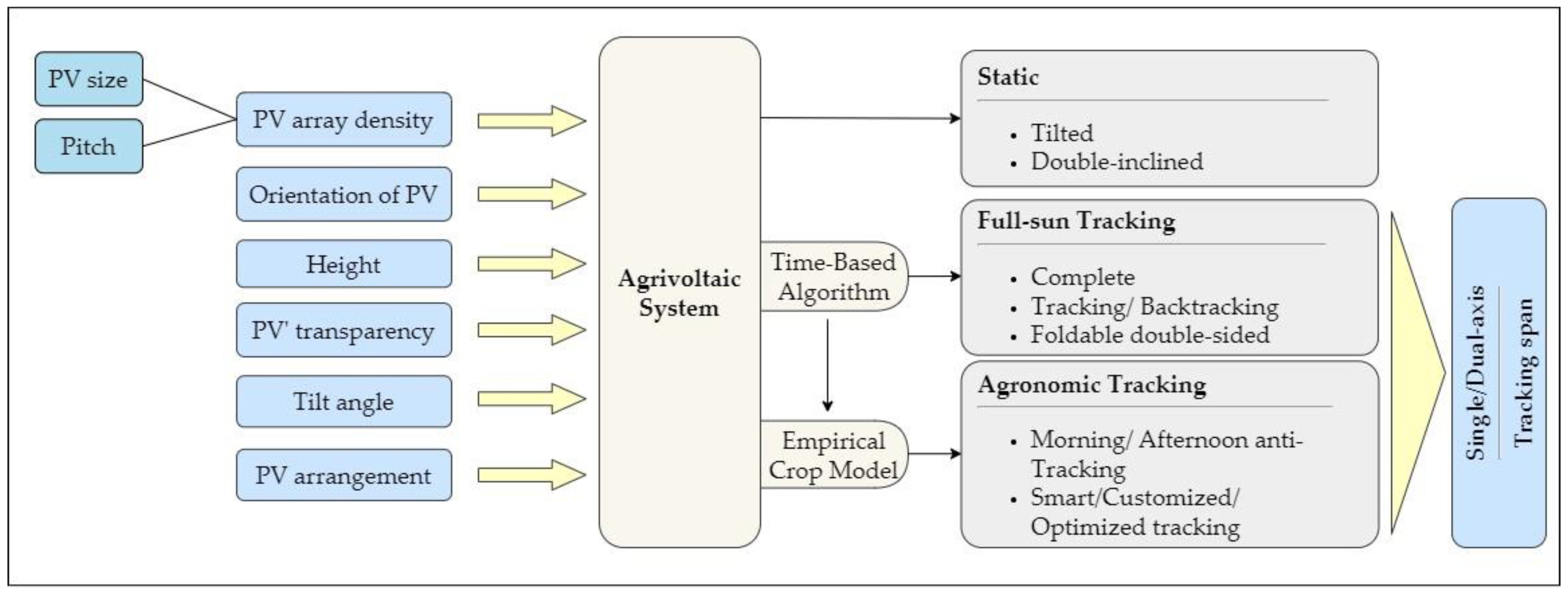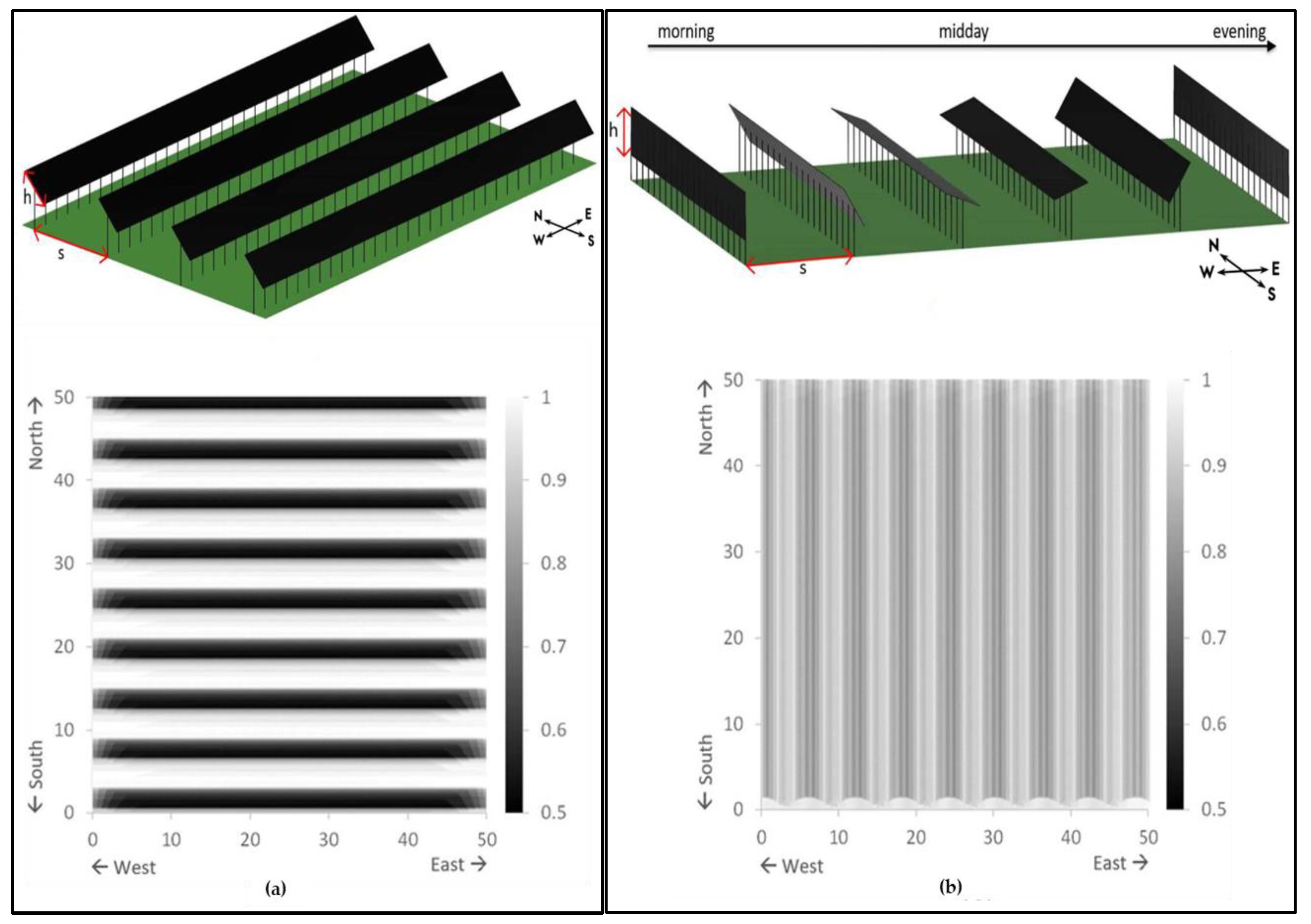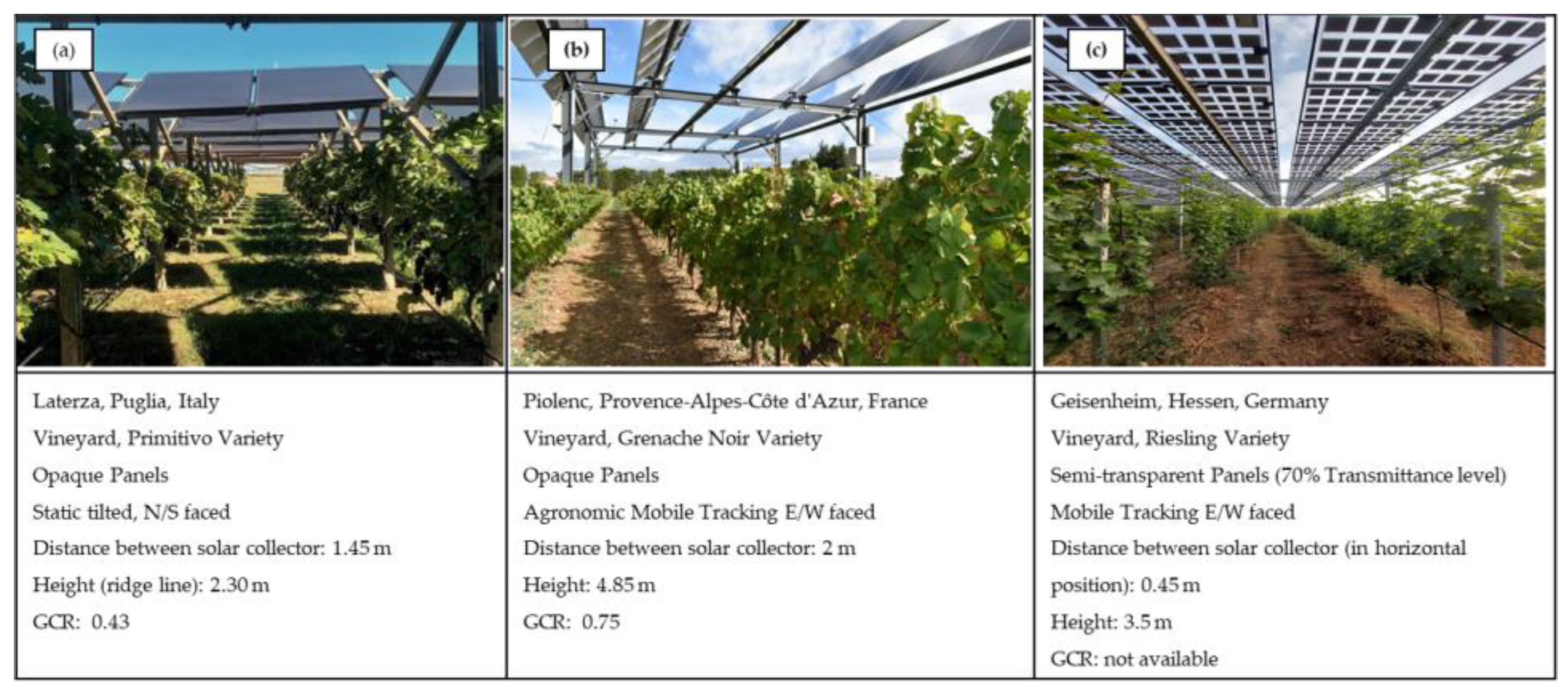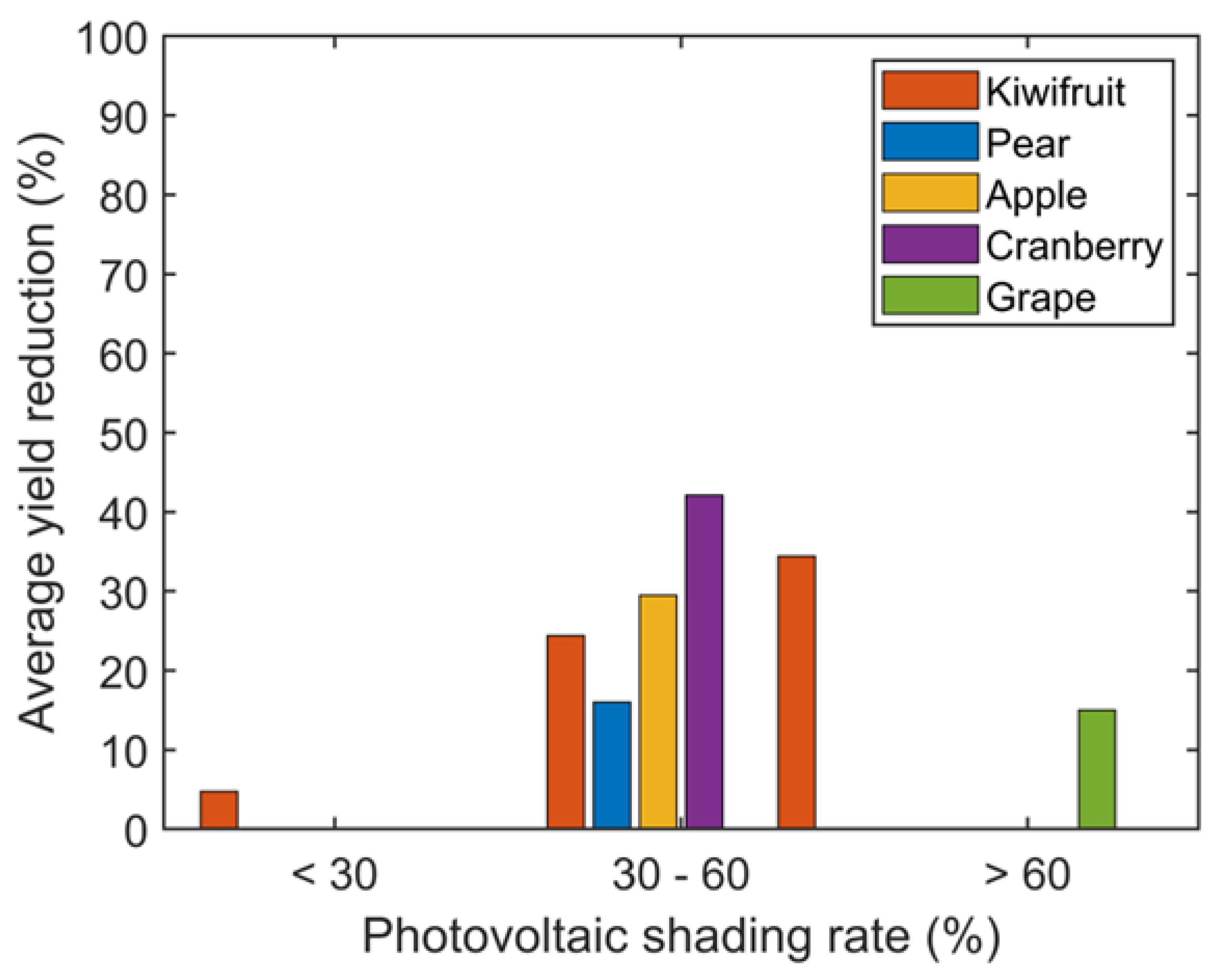Fruit Crop Species with Agrivoltaic Systems: A Critical Review
Abstract
:1. Introduction
2. Different Types of Agrivoltaic Systems
3. Panels and Fruit Species: A New Agricultural System
3.1. Microclimatic Conditions under the Panels
3.2. Fruit Crop Performance and Quality
| Fruit Crop Tested | Location | Type of Panels | Structure | Ground Coverage Ratio | Shading Rate (%) | Energy Production | Remarks | References | |
|---|---|---|---|---|---|---|---|---|---|
| Yield | Fruit Quality | ||||||||
| Apple | Mallemort, France | Single-axis horizontal, adaptive solar tracking | Opaque | 0.43 | 42% | - | Yield reduction from 27 to 32%, alternate bearing reduction | Minimum standard reached, but lower sugar concentration | [48,58,65] |
| Pear | Bierbeek, Belgium | double-sided, static, inclined | Semitransparent | 0.6 | 35% | 950 kWh/kWp | A 16% yield reduction (estimation) | Similar quality (estimation) | [32] |
| Grape | Valpolicella, Italy | Static, tilted | Opaque | - | 75% | - | Observed a decrease in yield, at least in two years | Total soluble solids were lower, reduction in both polyphenols and anthocyanins | [55] |
| Grape | Yeongheung, South Korea | Static, tilted | Opaque | - | <30% | - | Not significantly affected | Did not affect sugar content or anthocyanins, delay in skin coloration | [61] |
| Grape | Gyeongsan, South Korea | Static on umbrella-shaped facility, tilted | Opaque, bifacial, semitransparent | - | ≤30% | Opaque: 25.2 MWh Bifacial: 21.6 MWh Semitransparent: 25.7 MWh | Not available (berry weight and number not affected except for opaque type) | Similar sugar-content level, delay in coloration | [46] |
| Kiwifruit | Puijiang County, China | Static, tilted | Semitransparent | 0.15; 0.25; 0.31 | 19%; 30.4%, 38% | - | Remarkable yield reduction | Fruit volume reduction | [56] |
| Cranberries | Massachusetts, USA | Fixed | Plywood sheet | - | 29.3–41.5% | - | Significantly reduced yield | Significantly reduced fruit firmness and total soluble solids, skin color not affected | [54] |
4. Conclusions
Author Contributions
Funding
Data Availability Statement
Acknowledgments
Conflicts of Interest
Appendix A
Responses of Fruit Crops to Light Reduction
| Fruit Crop | Light Saturation Point (μmol Photon m–2 s–1) | Maximum Photosynthesis (μmol CO2 m–2 s–1) | PAR Reduction | Photosynthesis | Vegetative Growth | Reproductive Growth | SSC | Acidity | Ref. |
|---|---|---|---|---|---|---|---|---|---|
| Apple | 1200–1600 | 15–20 | (Shading net) | ↑ | No difference to number of fruits | ↑/↓ | No diff/↓ | [67,68] | |
| Grape | 1500 | 10–15 | 50% (Shading net) | No diff | ↑ | ↓ | ↑ | [69,70] | |
| Citrus (lemon, orange, mandarin) | 750–1000 | 15–22 | 40–50% (Shading net) | No diff/↑ | Taller trees, high leaf number | Low fruit set and number of fruits | ↑ | [67,69,70,71] | |
| Kiwifruit | 600–960 | 12–15 | (Grey nets) | High number of long shoots | Decrease in fruit production | ↑ | [67,72] | ||
| Pomegranate | - | - | 50% (Shading net) | Increased fruit weight and yield | ↓ | ↓ | [67,69] | ||
| Peach, nectarine, cherry | 800–1200 | 7–15 | ↑ | Enhanced fruit growth rates | [73,74] | ||||
| Fig | 700–1600 | 12–20 (or higher) | (Shading net) | Prolonged storage life of fresh fruits | [75,76,77] | ||||
| Blackberry | 750–1000 | 7–18 | 40% (Shading net) | ↓ | Increase in dry matter and length of canes | Longer harvesting period, higher yield | No diff | No diff | [78,79] |
References
- Van De Ven, D.-J.; Mittal, S.; Gambhir, A.; Lamboll, R.D.; Doukas, H.; Giarola, S.; Hawkes, A.; Koasidis, K.; Köberle, A.C.; McJeon, H.; et al. A Multimodel Analysis of Post-Glasgow Climate Targets and Feasibility Challenges. Nat. Clim. Chang. 2023, 13, 570–578. [Google Scholar] [CrossRef]
- Leal Filho, W.; Viera Trevisan, L.; Simon Rampasso, I.; Anholon, R.; Pimenta Dinis, M.A.; Londero Brandli, L.; Sierra, J.; Lange Salvia, A.; Pretorius, R.; Nicolau, M.; et al. When the Alarm Bells Ring: Why the UN Sustainable Development Goals May Not Be Achieved by 2030. J. Clean. Prod. 2023, 407, 137108. [Google Scholar] [CrossRef]
- Liu, T.-C.; Wu, Y.-C.; Chau, C.-F. An Overview of Carbon Emission Mitigation in the Food Industry: Efforts, Challenges, and Opportunities. Processes 2023, 11, 1993. [Google Scholar] [CrossRef]
- Chataut, G.; Bhatta, B.; Joshi, D.; Subedi, K.; Kafle, K. Greenhouse Gases Emission from Agricultural Soil: A Review. J. Agric. Food Res. 2023, 11, 100533. [Google Scholar] [CrossRef]
- Ahmed, M.; Shuai, C.; Ahmed, M. Analysis of Energy Consumption and Greenhouse Gas Emissions Trend in China, India, the USA, and Russia. Int. J. Environ. Sci. Technol. 2023, 20, 2683–2698. [Google Scholar] [CrossRef]
- Rokicki, T.; Perkowska, A.; Klepacki, B.; Bórawski, P.; Bełdycka-Bórawska, A.; Michalski, K. Changes in Energy Consumption in Agriculture in the EU Countries. Energies 2021, 14, 1570. [Google Scholar] [CrossRef]
- Mathur, S.; Waswani, H.; Singh, D.; Ranjan, R. Alternative Fuels for Agriculture Sustainability: Carbon Footprint and Economic Feasibility. AgriEngineering 2022, 4, 993–1015. [Google Scholar] [CrossRef]
- Pochwatka, P.; Kowalczyk-Juśko, A.; Sołowiej, P.; Wawrzyniak, A.; Dach, J. Biogas Plant Exploitation in a Middle-Sized Dairy Farm in Poland: Energetic and Economic Aspects. Energies 2020, 13, 6058. [Google Scholar] [CrossRef]
- Han, R.; Huo-Gen, W. N2N Regional Circular Agriculture Model in China: A Case Study of Luofang Biogas Project. Cogent Food Agric. 2023, 9, 2222563. [Google Scholar] [CrossRef]
- Goetzberger, A.; Zastrow, A. On the Coexistence of Solar-Energy Conversion and Plant Cultivation. Int. J. Sol. Energy 1982, 1, 55–69. [Google Scholar] [CrossRef]
- Dupraz, C.; Marrou, H.; Talbot, G.; Dufour, L.; Nogier, A.; Ferard, Y. Combining Solar Photovoltaic Panels and Food Crops for Optimising Land Use: Towards New Agrivoltaic Schemes. Renew. Energy 2011, 36, 2725–2732. [Google Scholar] [CrossRef]
- Hassanien, R.H.E.; Li, M.; Dong Lin, W. Advanced Applications of Solar Energy in Agricultural Greenhouses. Renew. Sustain. Energy Rev. 2016, 54, 989–1001. [Google Scholar] [CrossRef]
- Campana, P.E.; Stridh, B.; Amaducci, S.; Colauzzi, M. Optimisation of Vertically Mounted Agrivoltaic Systems. J. Clean. Prod. 2021, 325, 129091. [Google Scholar] [CrossRef]
- Toledo, C.; Scognamiglio, A. Agrivoltaic Systems Design and Assessment: A Critical Review, and a Descriptive Model towards a Sustainable Landscape Vision (Three-Dimensional Agrivoltaic Patterns). Sustainability 2021, 13, 6871. [Google Scholar] [CrossRef]
- U.S. Department of Energy Agrivoltaics Map. Available online: https://openei.org/wiki/InSPIRE/Agrivoltaics_Map (accessed on 16 March 2024).
- Tajima, M.; Iida, T. Evolution of Agrivoltaic Farms in Japan. AIP Conf. Proc. 2021, 2361, 030002. [Google Scholar]
- Chalgynbayeva, A.; Balogh, P.; Szőllősi, L.; Gabnai, Z.; Apáti, F.; Sipos, M.; Bai, A. The Economic Potential of Agrivoltaic Systems in Apple Cultivation—A Hungarian Case Study. Sustainability 2024, 16, 2325. [Google Scholar] [CrossRef]
- Sun’Agri. Available online: https://sunagri.fr/en/ (accessed on 16 March 2024).
- Graham, M.; Ates, S.; Melathopoulos, A.P.; Moldenke, A.R.; DeBano, S.J.; Best, L.R.; Higgins, C.W. Partial Shading by Solar Panels Delays Bloom, Increases Floral Abundance during the Late-Season for Pollinators in a Dryland, Agrivoltaic Ecosystem. Sci. Rep. 2021, 11, 7452. [Google Scholar] [CrossRef] [PubMed]
- Walston, L.J.; Hartmann, H.M.; Fox, L.; Macknick, J.; McCall, J.; Janski, J.; Jenkins, L. If You Build It, Will They Come? Insect Community Responses to Habitat Establishment at Solar Energy Facilities in Minnesota, USA. Environ. Res. Lett. 2024, 19, 014053. [Google Scholar] [CrossRef]
- Barron-Gafford, G.A.; Pavao-Zuckerman, M.A.; Minor, R.L.; Sutter, L.F.; Barnett-Moreno, I.; Blackett, D.T.; Thompson, M.; Dimond, K.; Gerlak, A.K.; Nabhan, G.P.; et al. Agrivoltaics Provide Mutual Benefits across the Food–Energy–Water Nexus in Drylands. Nat. Sustain. 2019, 2, 848–855. [Google Scholar] [CrossRef]
- Sturchio, M.A.; Kannenberg, S.A.; Knapp, A.K. Agrivoltaic Arrays Can Maintain Semi-Arid Grassland Productivity and Extend the Seasonality of Forage Quality. Appl. Energy 2024, 356, 122418. [Google Scholar] [CrossRef]
- Hassanpour Adeh, E.; Selker, J.S.; Higgins, C.W. Remarkable Agrivoltaic Influence on Soil Moisture, Micrometeorology and Water-Use Efficiency. PLoS ONE 2018, 13, e0203256. [Google Scholar] [CrossRef] [PubMed]
- Edouard, S.; Combes, D.; Van Iseghem, M.; Ng Wing Tin, M.; Escobar-Gutiérrez, A.J. Increasing Land Productivity with Agriphotovoltaics: Application to an Alfalfa Field. Appl. Energy 2023, 329, 120207. [Google Scholar] [CrossRef]
- Wydra, K.; Vollmer, V.; Busch, C.; Prichta, S. Agrivoltaic: Solar Radiation for Clean Energy and Sustainable Agriculture with Positive Impact on Nature. In Solar Radiation—Enabling Technologies, Recent Innovations, and Advancements for Energy Transition [Working Title]; IntechOpen: London, UK, 2023. [Google Scholar]
- Ramos-Fuentes, I.A.; Elamri, Y.; Cheviron, B.; Dejean, C.; Belaud, G.; Fumey, D. Effects of Shade and Deficit Irrigation on Maize Growth and Development in Fixed and Dynamic AgriVoltaic Systems. Agric. Water Manag. 2023, 280, 108187. [Google Scholar] [CrossRef]
- Chae, S.-H.; Kim, H.J.; Moon, H.-W.; Kim, Y.H.; Ku, K.-M. Agrivoltaic Systems Enhance Farmers’ Profits through Broccoli Visual Quality and Electricity Production without Dramatic Changes in Yield, Antioxidant Capacity, and Glucosinolates. Agronomy 2022, 12, 1415. [Google Scholar] [CrossRef]
- Ko, D.-Y.; Chae, S.-H.; Moon, H.-W.; Kim, H.; Seong, J.; Lee, M.-S.; Ku, K.-M. Agrivoltaic Farming Insights: A Case Study on the Cultivation and Quality of Kimchi Cabbage and Garlic. Agronomy 2023, 13, 2625. [Google Scholar] [CrossRef]
- Zhang, S.; Gong, J.; Xiao, C.; Yang, X.; Li, X.; Zhang, Z.; Song, L.; Zhang, W.; Dong, X.; Hu, Y. Bupleurum Chinense and Medicago Sativa Sustain Their Growth in Agrophotovoltaic Systems by Regulating Photosynthetic Mechanisms. Renew. Sustain. Energy Rev. 2024, 189, 114024. [Google Scholar] [CrossRef]
- Ciocia, A.; Enescu, D.; Amato, A.; Malgaroli, G.; Polacco, R.; Amico, F.; Spertino, F. Agrivoltaic System: A Case Study of PV Production and Olive Cultivation in Southern Italy. In Proceedings of the 2022 57th International Universities Power Engineering Conference (UPEC), Istanbul, Turkey, 30 August–2 September 2022; IEEE: Istanbul, Turkey, 2022; pp. 1–6. [Google Scholar]
- Mouhib, E.; Fernández-Solas, Á.; Pérez-Higueras, P.J.; Fernández-Ocaña, A.M.; Micheli, L.; Almonacid, F.; Fernández, E.F. Enhancing Land Use: Integrating Bifacial PV and Olive Trees in Agrivoltaic Systems. Appl. Energy 2024, 359, 122660. [Google Scholar] [CrossRef]
- Willockx, B.; Reher, T.; Lavaert, C.; Herteleer, B.; Van De Poel, B.; Cappelle, J. Design and Evaluation of an Agrivoltaic System for a Pear Orchard. Appl. Energy 2024, 353, 122166. [Google Scholar] [CrossRef]
- Atlan, A.; Hornoy, B.; Delerue, F.; Gonzalez, M.; Pierre, J.-S.; Tarayre, M. Phenotypic Plasticity in Reproductive Traits of the Perennial Shrub Ulex Europaeus in Response to Shading: A Multi-Year Monitoring of Cultivated Clones. PLoS ONE 2015, 10, e0137500. [Google Scholar] [CrossRef]
- Touil, S.; Richa, A.; Fizir, M.; Bingwa, B. Shading Effect of Photovoltaic Panels on Horticulture Crops Production: A Mini Review. Rev. Env. Sci. Biotechnol. 2021, 20, 281–296. [Google Scholar] [CrossRef]
- Dupraz, C. Assessment of the Ground Coverage Ratio of Agrivoltaic Systems as a Proxy for Potential Crop Productivity. Agrofor. Syst. 2023, 1–18. [Google Scholar] [CrossRef]
- Laub, M.; Pataczek, L.; Feuerbacher, A.; Zikeli, S.; Högy, P. Contrasting Yield Responses at Varying Levels of Shade Suggest Different Suitability of Crops for Dual Land-Use Systems: A Meta-Analysis. Agron. Sustain. Dev. 2022, 42, 51. [Google Scholar] [CrossRef]
- Lopez, G.; Chopard, J.; Persello, S.; Juillion, P.; Lesniak, V.; Vercambre, G.; Génard, M.; Fumey, D. Agrivoltaic Systems: An Innovative Technique to Protect Fruit Trees from Climate Change. Acta Hortic. 2023, 1366, 173–186. [Google Scholar] [CrossRef]
- Widmer, J.; Christ, B.; Grenz, J.; Norgrove, L. Agrivoltaics, a Promising New Tool for Electricity and Food Production: A Systematic Review. Renew. Sustain. Energy Rev. 2024, 192, 114277. [Google Scholar] [CrossRef]
- Aroca-Delgado, R.; Pérez-Alonso, J.; Callejón-Ferre, Á.; Velázquez-Martí, B. Compatibility between Crops and Solar Panels: An Overview from Shading Systems. Sustainability 2018, 10, 743. [Google Scholar] [CrossRef]
- Sarr, A.; Soro, Y.M.; Tossa, A.K.; Diop, L. Agrivoltaic, a Synergistic Co-Location of Agricultural and Energy Production in Perpetual Mutation: A Comprehensive Review. Processes 2023, 11, 948. [Google Scholar] [CrossRef]
- Ali Khan Niazi, K.; Victoria, M. Comparative Analysis of Photovoltaic Configurations for Agrivoltaic Systems in Europe. Prog. Photovolt. 2023, 31, 1101–1113. [Google Scholar] [CrossRef]
- Tahir, Z.; Butt, N.Z. Implications of Spatial-Temporal Shading in Agrivoltaics under Fixed Tilt & Tracking Bifacial Photovoltaic Panels. Renew. Energy 2022, 190, 167–176. [Google Scholar] [CrossRef]
- Valle, B.; Simonneau, T.; Sourd, F.; Pechier, P.; Hamard, P.; Frisson, T.; Ryckewaert, M.; Christophe, A. Increasing the Total Productivity of a Land by Combining Mobile Photovoltaic Panels and Food Crops. Appl. Energy 2017, 206, 1495–1507. [Google Scholar] [CrossRef]
- Riaz, M.H.; Imran, H.; Butt, N.Z. Optimization of PV Array Density for Fixed Tilt Bifacial Solar Panels for Efficient Agrivoltaic Systems. In Proceedings of the 2020 47th IEEE Photovoltaic Specialists Conference (PVSC), Calgary, AB, Canada, 15 June–21 August 2020; IEEE: Calgary, AB, Canada, 2020; pp. 1349–1352. [Google Scholar]
- Gorjian, S.; Bousi, E.; Özdemir, Ö.E.; Trommsdorff, M.; Kumar, N.M.; Anand, A.; Kant, K.; Chopra, S.S. Progress and Challenges of Crop Production and Electricity Generation in Agrivoltaic Systems Using Semi-Transparent Photovoltaic Technology. Renew. Sustain. Energy Rev. 2022, 158, 112126. [Google Scholar] [CrossRef]
- Cho, J.; Park, S.M.; Park, A.R.; Lee, O.C.; Nam, G.; Ra, I.-H. Application of Photovoltaic Systems for Agriculture: A Study on the Relationship between Power Generation and Farming for the Improvement of Photovoltaic Applications in Agriculture. Energies 2020, 13, 4815. [Google Scholar] [CrossRef]
- Ma Lu, S.; Zainali, S.; Stridh, B.; Avelin, A.; Amaducci, S.; Colauzzi, M.; Campana, P.E. Photosynthetically Active Radiation Decomposition Models for Agrivoltaic Systems Applications. Sol. Energy 2022, 244, 536–549. [Google Scholar] [CrossRef]
- Juillion, P.; Lopez, G.; Fumey, D.; Lesniak, V.; Génard, M.; Vercambre, G. Shading Apple Trees with an Agrivoltaic System: Impact on Water Relations, Leaf Morphophysiological Characteristics and Yield Determinants. Sci. Hortic. 2022, 306, 111434. [Google Scholar] [CrossRef]
- Casares De La Torre, F.J.; Varo, M.; López-Luque, R.; Ramírez-Faz, J.; Fernández-Ahumada, L.M. Design and Analysis of a Tracking / Backtracking Strategy for PV Plants with Horizontal Trackers after Their Conversion to Agrivoltaic Plants. Renew. Energy 2022, 187, 537–550. [Google Scholar] [CrossRef]
- Lama, R.K.; Jeong, H. Design and Performance Analysis of Foldable Solar Panel for Agrivoltaics System. Sensors 2024, 24, 1167. [Google Scholar] [CrossRef]
- Chopard, J.; Bisson, A.; Lopez, G.; Persello, S.; Richert, C.; Fumey, D. Development of a Decision Support System to Evaluate Crop Performance under Dynamic Solar Panels. AIP Conf. Proc. 2021, 2361, 050001. [Google Scholar]
- Grubbs, E.K.; Gruss, S.M.; Schull, V.Z.; Gosney, M.J.; Mickelbart, M.V.; Brouder, S.; Gitau, M.W.; Bermel, P.; Tuinstra, M.R.; Agrawal, R. Optimized Agrivoltaic Tracking for Nearly-Full Commodity Crop and Energy Production. Renew. Sustain. Energy Rev. 2024, 191, 114018. [Google Scholar] [CrossRef]
- Willockx, B.; Lavaert, C.; Cappelle, J. Performance Evaluation of Vertical Bifacial and Single-Axis Tracked Agrivoltaic Systems on Arable Land. Renew. Energy 2023, 217, 119181. [Google Scholar] [CrossRef]
- Mupambi, G.; Sandler, H.A.; Jeranyama, P. Installation of an Agrivoltaic System Influences Microclimatic Conditions and Leaf Gas Exchange in Cranberry. Acta Hortic. 2022, 1337, 117–124. [Google Scholar] [CrossRef]
- Ferrara, G.; Boselli, M.; Palasciano, M.; Mazzeo, A. Effect of Shading Determined by Photovoltaic Panels Installed above the Vines on the Performance of Cv. Corvina (Vitis vinifera L.). Sci. Hortic. 2023, 308, 111595. [Google Scholar] [CrossRef]
- Jiang, S.; Tang, D.; Zhao, L.; Liang, C.; Cui, N.; Gong, D.; Wang, Y.; Feng, Y.; Hu, X.; Peng, Y. Effects of Different Photovoltaic Shading Levels on Kiwifruit Growth, Yield and Water Productivity under “Agrivoltaic” System in Southwest China. Agric. Water Manag. 2022, 269, 107675. [Google Scholar] [CrossRef]
- Williams, H.J.; Hashad, K.; Wang, H.; Max Zhang, K. The Potential for Agrivoltaics to Enhance Solar Farm Cooling. Appl. Energy 2023, 332, 120478. [Google Scholar] [CrossRef]
- Juillion, P.; Lopez, G.; Fumey, D.; Lesniak, V.; Génard, M.; Vercambre, G. Combining Field Experiments under an Agrivoltaic System and a Kinetic Fruit Model to Understand the Impact of Shading on Apple Carbohydrate Metabolism and Quality. Agrofor. Syst. 2024, 1–18. [Google Scholar] [CrossRef]
- Weselek, A.; Bauerle, A.; Hartung, J.; Zikeli, S.; Lewandowski, I.; Högy, P. Agrivoltaic System Impacts on Microclimate and Yield of Different Crops within an Organic Crop Rotation in a Temperate Climate. Agron. Sustain. Dev. 2021, 41, 59. [Google Scholar] [CrossRef]
- Marrou, H.; Wery, J.; Dufour, L.; Dupraz, C. Productivity and Radiation Use Efficiency of Lettuces Grown in the Partial Shade of Photovoltaic Panels. Eur. J. Agron. 2013, 44, 54–66. [Google Scholar] [CrossRef]
- Ahn, S.Y.; Lee, D.B.; Lee, H.I.; Myint, Z.L.; Min, S.Y.; Kim, B.M.; Oh, W.; Jung, J.H.; Yun, H.K. Grapevine Growth and Berry Development under the Agrivoltaic Solar Panels in the Vineyards. J. Bio-Environ. Control 2022, 31, 356–365. [Google Scholar] [CrossRef]
- Schweiger, A.H.; Pataczek, L. How to Reconcile Renewable Energy and Agricultural Production in a Drying World. Plants People Planet. 2023, 5, 650–661. [Google Scholar] [CrossRef]
- Warmann, E.; Jenerette, G.D.; Barron-Gafford, G.A. Agrivoltaic System Design Tools for Managing Trade-Offs between Energy Production, Crop Productivity and Water Consumption. Environ. Res. Lett. 2024, 19, 034046. [Google Scholar] [CrossRef]
- Duchemin, M.; Nardin, G.; Ackermann, M.; Petri, D.; Levrat, J.; Chudy, D.; Despeisse, M.; Ballif, C.; Baumann, M.; Christ, B.; et al. Dynamic agrivoltaics with raspberry crops: Field trial results. In Proceedings of the Agrivoltaics2023, Daegu, Republic of Korea, 12–14 April 2023. [Google Scholar]
- Juillion, P.; Lopez, G.; Fumey, D.; Génard, M.; Vercambre, G. Analysis and Modelling of Tree Shading Impacts on Apple Fruit Quality: Case Study with an Agrivoltaic System. Acta Hortic. 2023, 1366, 187–194. [Google Scholar] [CrossRef]
- Rosati, A.; Kyle, P.; Azad, D.; Maggie, G.; Serkan, A.; Kirschten, H.M.; Higgins, C.W. Agroforestry versus Agrivoltaic: Spectral Composition of Transmitted Radiation and Implications for Understory Crops. Agrofor. Syst. 2023, 1–14. [Google Scholar] [CrossRef]
- Manja, K.; Aoun, M. The Use of Nets for Tree Fruit Crops and Their Impact on the Production: A Review. Sci. Hortic. 2019, 246, 110–122. [Google Scholar] [CrossRef]
- Greer, D.H. Photosynthetic Light Responses of Apple (Malus Domestica) Leaves in Relation to Leaf Temperature, CO2 and Leaf Nitrogen on Trees Grown in Orchard Conditions. Funct. Plant Biol. 2018, 45, 1149. [Google Scholar] [CrossRef] [PubMed]
- Mditshwa, A.; Magwaza, L.S.; Tesfay, S.Z. Shade Netting on Subtropical Fruit: Effect on Environmental Conditions, Tree Physiology and Fruit Quality. Sci. Hortic. 2019, 256, 108556. [Google Scholar] [CrossRef]
- Restrepo-Diaz, H.; Sánchez-Reinoso, A.D. Ecophysiology of Fruit Crops: A Glance at Its Impact on Fruit Crop Productivity. In Fruit Crops; Elsevier: Amsterdam, The Netherlands, 2020; pp. 59–66. ISBN 978-0-12-818732-6. [Google Scholar]
- Albrigo, L.G.; Stelinski, L.L.; Timmer, L.W. (Eds.) Citrus, 2nd ed.; CABI: Wallingford, UK, 2019; ISBN 978-1-84593-815-4. [Google Scholar]
- Greer, D.H.; Halligan, E.A. Photosynthetic and Fluorescence Light Responses for Kiwifruit (Actinidia Deliciosa) Leaves at Different Stages of Development on Vines Grown at Two Different Photon Flux Densities. Funct. Plant Biol. 2001, 28, 373–382. [Google Scholar] [CrossRef]
- Quero-García, J.; Lezzoni, A.; Puławska, J.; Lang, G. (Eds.) Cherries: Botany, Production and Uses; CABI: Wallingford, UK, 2017; ISBN 978-1-78064-837-8. [Google Scholar]
- Pavel, E.W.; DeJong, T.M. Seasonal CO2 Exchange Patterns of Developing Peach (Prunus persica) Fruits in Response to Temperature, Light and CO2 Concentration. Physiol. Plant. 1993, 88, 322–330. [Google Scholar] [CrossRef]
- Sarkhosh, A.; Yavari, A.; Ferguson, L. (Eds.) The Fig: Botany, Production and Uses; CABI: Wallingford, UK, 2022; ISBN 978-1-78924-288-1. [Google Scholar]
- Zafer Can, H.; Aksoy, U. Seasonal and Diurnal Photosynthetic Behaviour of Fig (Ficus carica L.) under Semi-Arid Climatic Conditions. Acta Agric. Scand. Sect. B Soil. Plant Sci. 2007, 57, 297–306. [Google Scholar] [CrossRef]
- Zare, H.; Shirvanian, A.R.; Sharifzadeh, H.-R. The Effect of Installation Time and Color of Shading Covering Nets on Some Characteristics of Leaf and Fruit in Two Commercial Fig Cultivars under Rainfed Conditions. J. Plant Process Funct. 2023, 12, 43–58. [Google Scholar]
- Lykins, S.; Scammon, K.; Lawrence, B.T.; Melgar, J.C. Photosynthetic Light Response of Floricane Leaves of Erect Blackberry Cultivars from Fruit Development into the Postharvest Period. HortScience 2021, 56, 347–351. [Google Scholar] [CrossRef]
- Rotundo, A.; Forlani, M.; Di Vaio, C. Influence of shading net on vegetative and productive characteristics, gas exchange and chlorophyll content of the leaves in two blackberry (Rubus ulmifolius Schott.) Cultivars. Acta Hortic. 1998, 457, 333–340. [Google Scholar] [CrossRef]




Disclaimer/Publisher’s Note: The statements, opinions and data contained in all publications are solely those of the individual author(s) and contributor(s) and not of MDPI and/or the editor(s). MDPI and/or the editor(s) disclaim responsibility for any injury to people or property resulting from any ideas, methods, instructions or products referred to in the content. |
© 2024 by the authors. Licensee MDPI, Basel, Switzerland. This article is an open access article distributed under the terms and conditions of the Creative Commons Attribution (CC BY) license (https://creativecommons.org/licenses/by/4.0/).
Share and Cite
Magarelli, A.; Mazzeo, A.; Ferrara, G. Fruit Crop Species with Agrivoltaic Systems: A Critical Review. Agronomy 2024, 14, 722. https://doi.org/10.3390/agronomy14040722
Magarelli A, Mazzeo A, Ferrara G. Fruit Crop Species with Agrivoltaic Systems: A Critical Review. Agronomy. 2024; 14(4):722. https://doi.org/10.3390/agronomy14040722
Chicago/Turabian StyleMagarelli, Andrea, Andrea Mazzeo, and Giuseppe Ferrara. 2024. "Fruit Crop Species with Agrivoltaic Systems: A Critical Review" Agronomy 14, no. 4: 722. https://doi.org/10.3390/agronomy14040722






